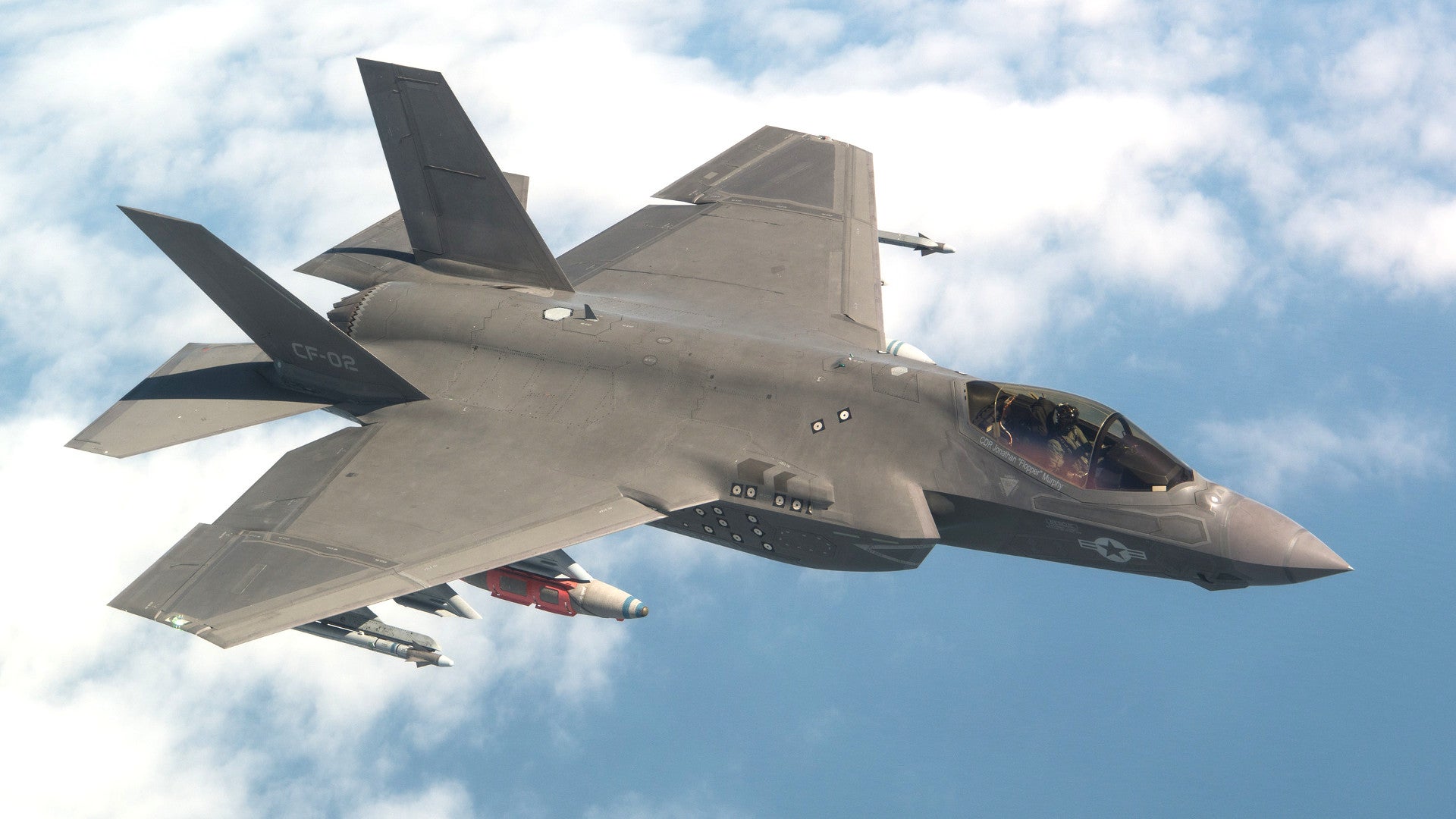After more than a decade, the F-35 program has reached a major milestone and finished flight tests related to the System Development and Demonstration phase, or SDD. But as with anything relating to the Joint Strike Fighter, this announcement comes with significant caveats and amid new controversies, including that the Joint Program Office deleted a number of test points in order to meet its goals and still couldn’t meet a much revised schedule.
One of the U.S. Navy’s operational test F-35C, known as CF-2, completed the last SDD flight test on April 11, 2018. The objective of that particular experiment was to gather load carrying data regarding the simultaneous external underwing carriage of two 2,000-pound class GBU-31/B Joint Direct Attack Munition (JDAM) GPS-guided bombs and two AIM-9X Sidewinder air-to-air missiles. In total, since 2006, the Joint Strike Fighter program’s Integrated Test Force completed more than 17,000 flight hours across 9,200 test flights, which hit more than 65,000 test points relating to the aircraft’s various mission systems and weapons employment.
“Completing F-35 SDD flight test is the culmination of years of hard work and dedication from the joint government and industry team,” U.S. Navy Vice Admiral Mathias Winter, head of the F-35 Joint Program Office, said in a statement on April 12, 2018. “The F-35 flight test program represents the most comprehensive, rigorous, and the safest developmental flight test program in aviation history,” Greg Ulmer, Lockheed Martin’s Vice President and General Manager for the F-35 program, declared.
The nearly 12 year long effort, which cost approximately $60 billion dollars, included more than 180 weapon separation tests, nearly 50 weapon delivery accuracy tests, and more than 30 mission effectiveness tests. The latter events included multi-ship missions with as many as eight F-35s flying together.
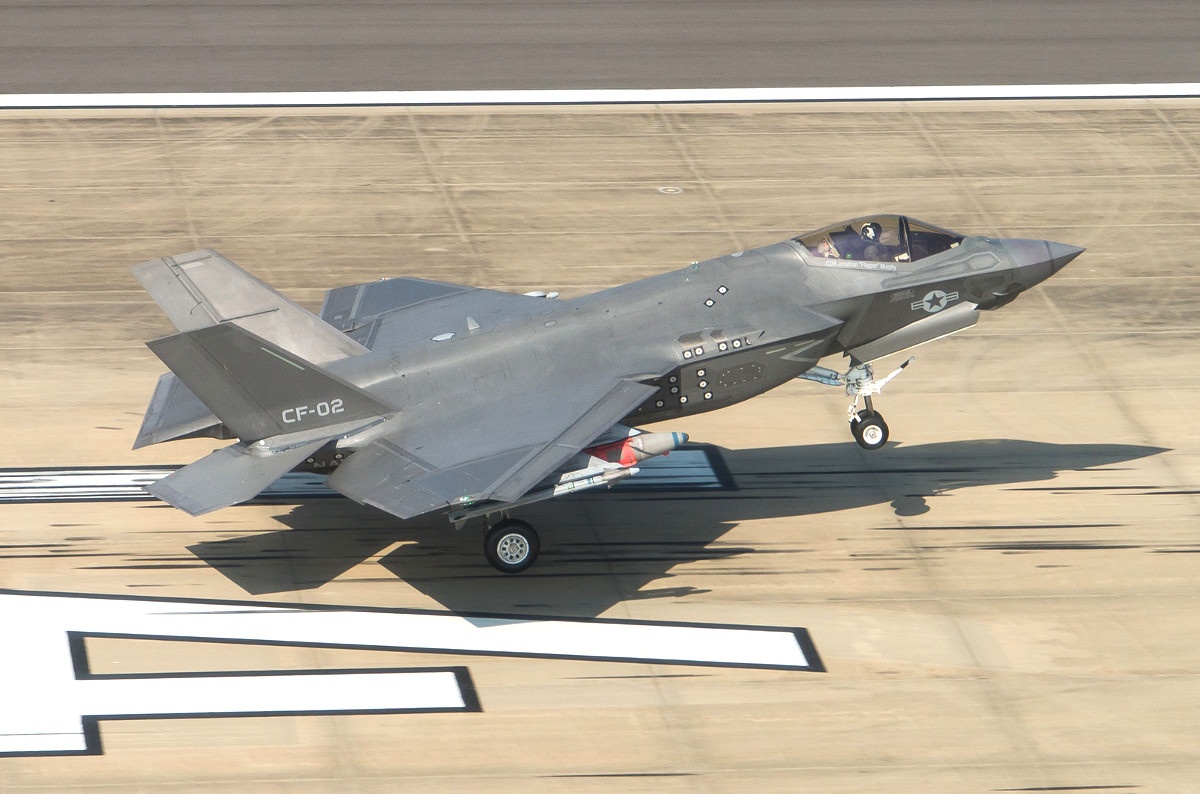
There were six deployments of Navy and Marine Corps F-35s from the Integrated Test Team aboard Navy ships, as well. Marine F-35Bs conducted more than 1,500 vertical landing-related tests both at sea and on land.
The completion of these flight tests paves the way for the aircraft to finally start independent initial operational test and evaluation, or IOT&E, to fully assess the readiness of the three F-35 variants for actual combat. Only after that process finishes up will the program officially complete its SDD phase. After that, the Pentagon will be able to officially approve full-rate production of the aircraft if the jets have successfully met the test parameters. Keep in mind that the services are already buying 77 F-35s this year, so “full-rate production” isn’t really a relative term.

One would imagine that all of this would be cause for celebration from both the F-35’s supporters and critics. This is an important development for a program with such a troubled developmental history and would appear to be a demonstration of actual and significant progress after years of delays and other issues.
But as always seems to be the case with regards to the F-35, the announcement is already mired in controversy. Most immediately, this announcement was originally supposed to have come in January 2018.
In an annual review of the program it released in January 2018, the Pentagon’s Office of the Director of Operational Test and Evaluation, which oversees all such activities across the U.S. military, had said that timetable was optimistic. This office, commonly referred to simply as DOT&E, expected the last SDD flight tests to likely come later in the second quarter of the 2018 fiscal year.
That quarter ended on March 30, 2018. And this is to say nothing of previous delays, as well as the Pentagon’s decision to “re-baseline” the program entirely, effectively shifting the goal posts dramatically, in 2011. The full-rate production decision is already five years behind schedule, at least according to the schedule as it existed in 2009.
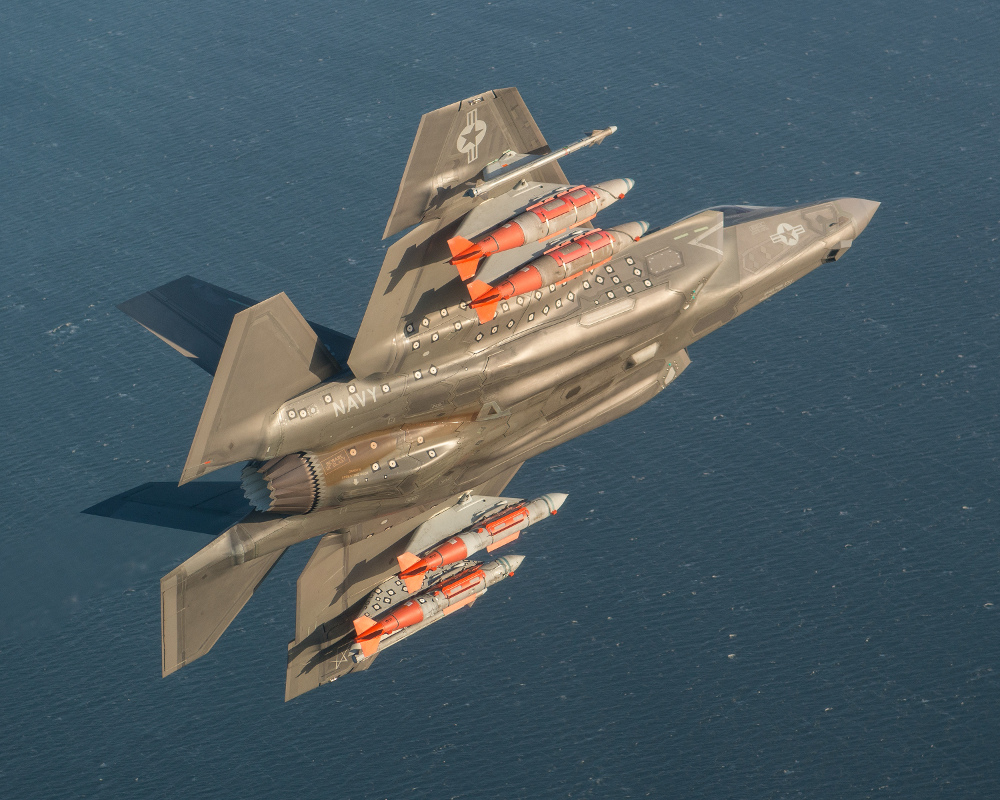
Perhaps more worrying is the fact that, despite gathering data on more than 65,000 test points, the F-35 program only met this much delayed SDD flight test schedule by deleting additional test points and accepting potentially flawed data. According to DOT&E, significant numbers of test flights involved aircraft with earlier editions of the critical, but troublesome onboard mission software, among other things, which may not reflect the actual capabilities of the stealth fighters as they exist now.
Even with the latest iteration of the Block 3F software package, which Lockheed Martin and the Air Force both touted as providing “full combat capability,” there were dozens of known deficiencies remaining as of September 2017, which was when the reporting period for DOT&E’s most recent review ended. Some of those affect weapon accuracy, such as a persistent error that causes the F-35A’s internal 25mm cannon to reportedly still shoot to the right of the pilot’s point of aim.

The Joint Program Office has been watering down the software requirements for years already, too, securing an interim, limited capability Block 3i software suite to meet some early test objectives and avoid even more embarrassing delays. Before that, the baseline Block 3 was supposed to represent a fully functional package, a requirement the initial iterations of the supposedly “final” Block 3F code failed to meet, as well.
It could also otherwise impede the ability of the aircraft’s various complex systems to properly share and display information to the pilot, other F-35s and different aircraft, or throughout ground-based networks. There are other ongoing occupational hazards, as well, including worrying reports of incidents of hypoxia-like symptoms among pilots flying Air Force F-35As.
Marine and Navy F-35 pilots have reported a “green glow” in their helmet’s display that can dangerously obscure their vision at night, especially during attempts to land on aircraft carriers and amphibious ships, as well. Lockheed Martin has only recently begun to implement fixes for that problem across the B and C model fleets.
The video below includes footage showing problems F-35 pilots have experienced with the displays on their helmets.

Lockheed Martin does not even expect to have finished installing production-representative software and other modifications on the entire fleet of 23 operational test F-35s until August 2018, according to DOT&E. In addition, thanks to a process known as concurrency, the U.S. military already owns hundreds of F-35s that could also need costly modifications or end up relegated to secondary, non-combat roles. Even then, problems with earlier systems mean that those older aircraft have some of the lowest availability rates. In March 2018, U.S. Marine Corps Lieutenant General Steven Rudder, the service’s Deputy Commandant for Aviation, told members of Congress that, on average, less than 40 percent of his F-35Bs with the older Block 2B were mission capable at any one time.
And yet, the Joint Program Office has continued to argue that it will be able to mitigate these issues through another concurrent process, known as Continuous Capability Development and Delivery, or C2D2. This multi-billion dollar effort, the requirements of which remains largely undefined by Vice Admiral Winter’s own admission at the March 2018 hearing, will add in many of the still missing features as fixes to the software and physical components become available.
All of this can only call into question whether the F-35s that perform the up-coming IOT&E tests will reflect the true capabilities of the existing fleet or future aircraft, whether they pass or fail in those events. It also does nothing to address what growing issues Lockheed Martin is having as it works to scale up its production capacity and concerns about the operating and long-term sustainment costs for such an advanced platform. During the March 2018 hearing, U.S. Air Force Lieutenant General Jerry Harris, Deputy Chief of Staff for Plans, Programs, and Requirements, said that it was still costing his service approximately $50,000 per flight hour to fly its F-35As, roughly twice the cost per flight hour to fly an F-16C/D Viper, which the Joint Strike Fighters are slated to replace.
On April 11, 2018, a report from Reuters revealed that the F-35 Joint Program Office had stopped accepting new aircraft over a contract dispute regarding the bill for a so-called “quality escape” related to a corrosion issue that emerged in 2017. Though Lockheed Martin has solved the defect, which would have impacted the aircraft’s low-observable capabilities, it is now locked in a dispute with U.S. government over who will pay what costs associated with those repairs and any other related corrective actions.
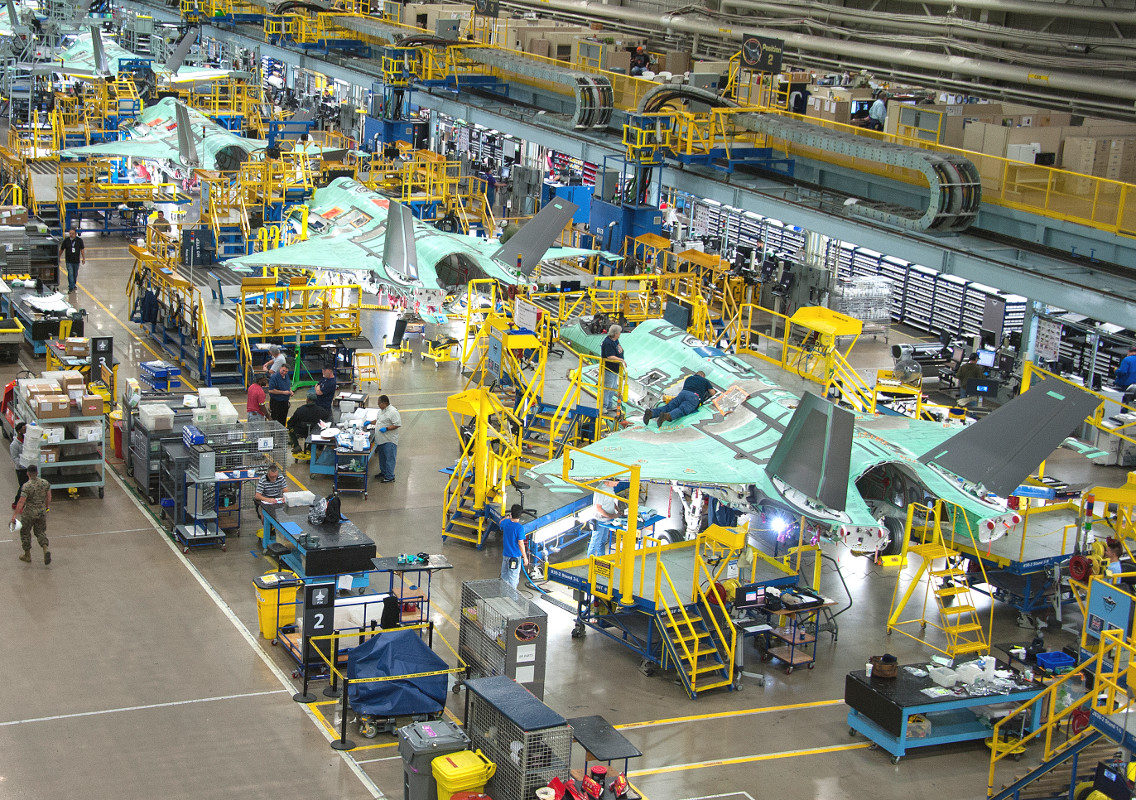
“Per the direction of the program executive officer, F-35 deliveries have been temporarily paused while the government and Lockheed Martin reach an agreement on a contractual issue regarding repair work to remediate the known aircraft fastener hole primer quality escape,” the F-35 joint program office said in a statement to Defense News. “This is not a safety of flight issue but rather a contractual resourcing issue that needs to be resolved. The government has implemented this pause to ensure the warfighter receives a quality product from industry.”
The Maryland-headquartered defense contractor is also in the midst of tense negotiations with the U.S. military over the sale of another block of low-production aircraft. In February 2018, Vice Admiral Winter went so far as to complain to the press that Lockheed Martin was being almost painfully uncooperative over the deal and that the F-35’s unit costs remained too high across all three variants. Earlier that month, Ellen Lord, Undersecretary of Defense for Acquisition and Sustainment, effectively the Pentagon’s top purchasing officer, said that the Department of Defense as a whole would be unable to pay for the planned fleets of Joint Strike Fighters in the long term unless the sustainment costs came down.
So, while the F-35 program has apparently successfully met the demands of its extended SDD flight test schedule, it remains unclear how representative that data is of the aircraft or its capabilities, at present or in the future. Even if it is, which may become more apparent during the ITO&E process, there remain other serious questions about the long-term viability of the service’s existing plans for the aircraft.
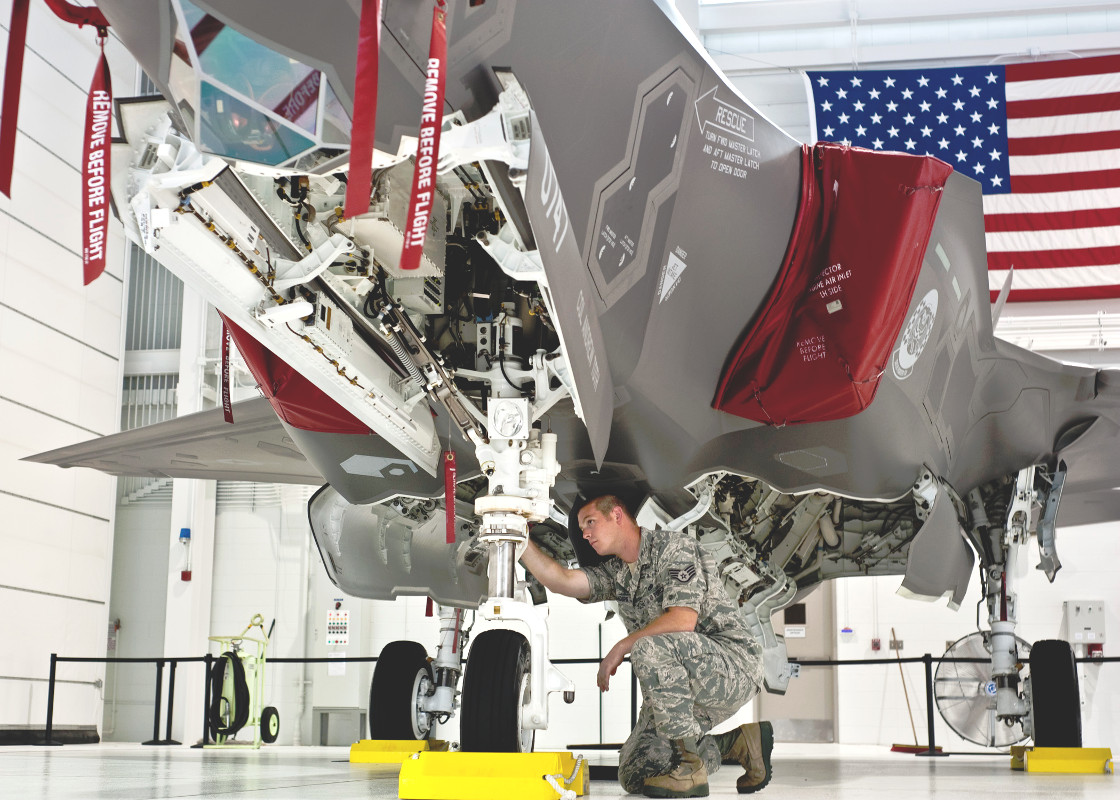
And while this latest milestone does show the F-35 project is making real progress, the manner in which it has occurred is yet another example of official pronouncements employing obtuse and “technically correct” verbiage that can obscure the obvious and still significant issues that project faces. This only diminishes the impact of positive news that emerges since it is immediately bogged down in caveats and asterisks.
In this case, continuing to press ahead with an aircraft that might not be ready or based on information gathered using aircraft that may not reflect the state of the fleet as a whole, including aircraft the Air Force and Marine Corps have already committed to combat operations without the benefit of independent IOT&E tests, could also lead to both embarrassment and more dangerous miscalculations in the future. It is important for both aviators and combatant commanders to have a good understanding of the capabilities available to them and confidence that those systems will be able to perform in potentially life-and-death situations.
The Navy continues to decline to declare an initial operational capability with the F-35C until the SDD phase is complete. There are also plans in the works to eventually shutter the Joint Program Office and let the individual services decide the fate of their F-35s independently.
In the meantime, it offers no benefit to the security of the United States to field weapon systems that lack significant capabilities for any reason without being honest about those issues. The multi-national nature of the F-35 program means that these decisions impact the capabilities and credibility of nearly a dozen allies, and potentially more, as well. The Pentagon’s refusal to accept the most recent batch of jets over the contract dispute will delay the delivery of one to Australia and another Norway, underscoring the interdependence inherent in the program for many smaller participants.
All told, it is definitely a good thing that the F-35 program is moving forward in its testing process, but lessons must be learned from its troubled history and it does no good to rush ahead only to create an illusion of real progress.
Contact the author: jtrevithickpr@gmail.com
